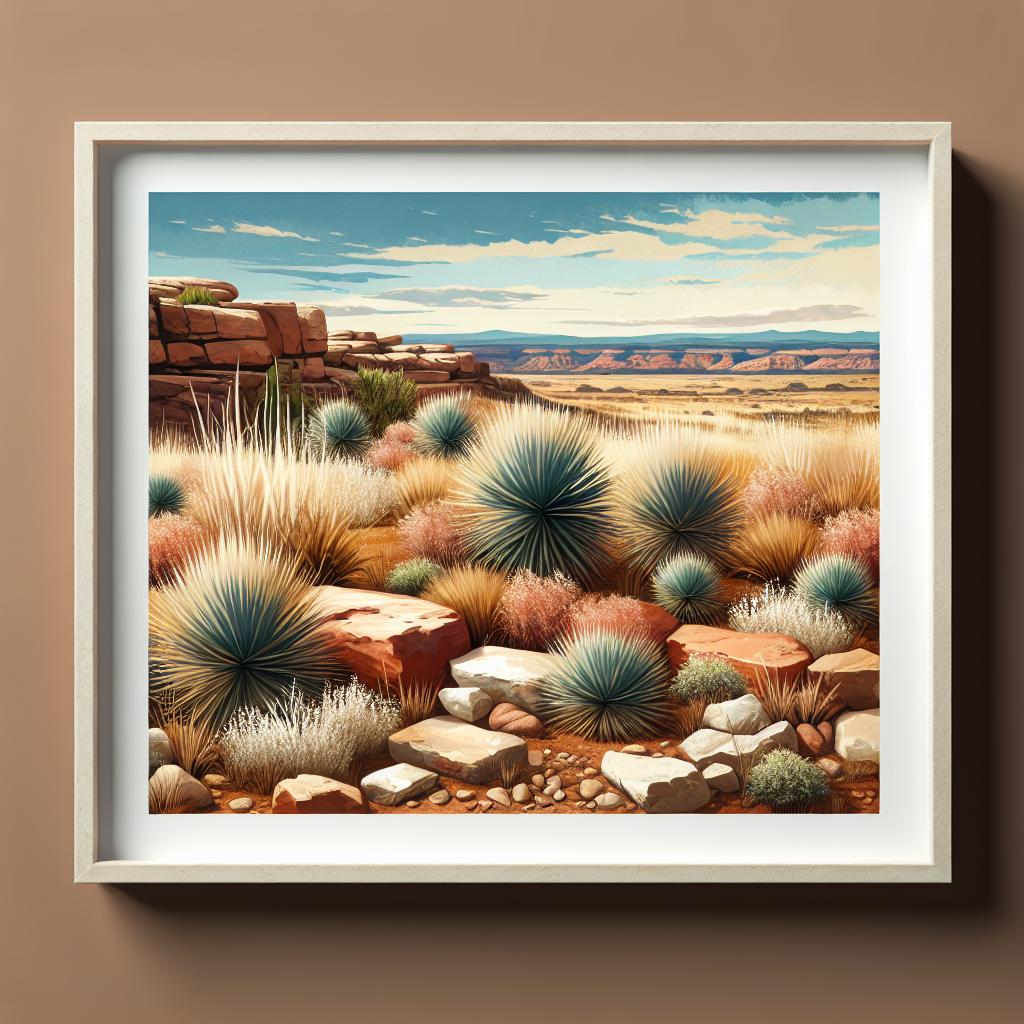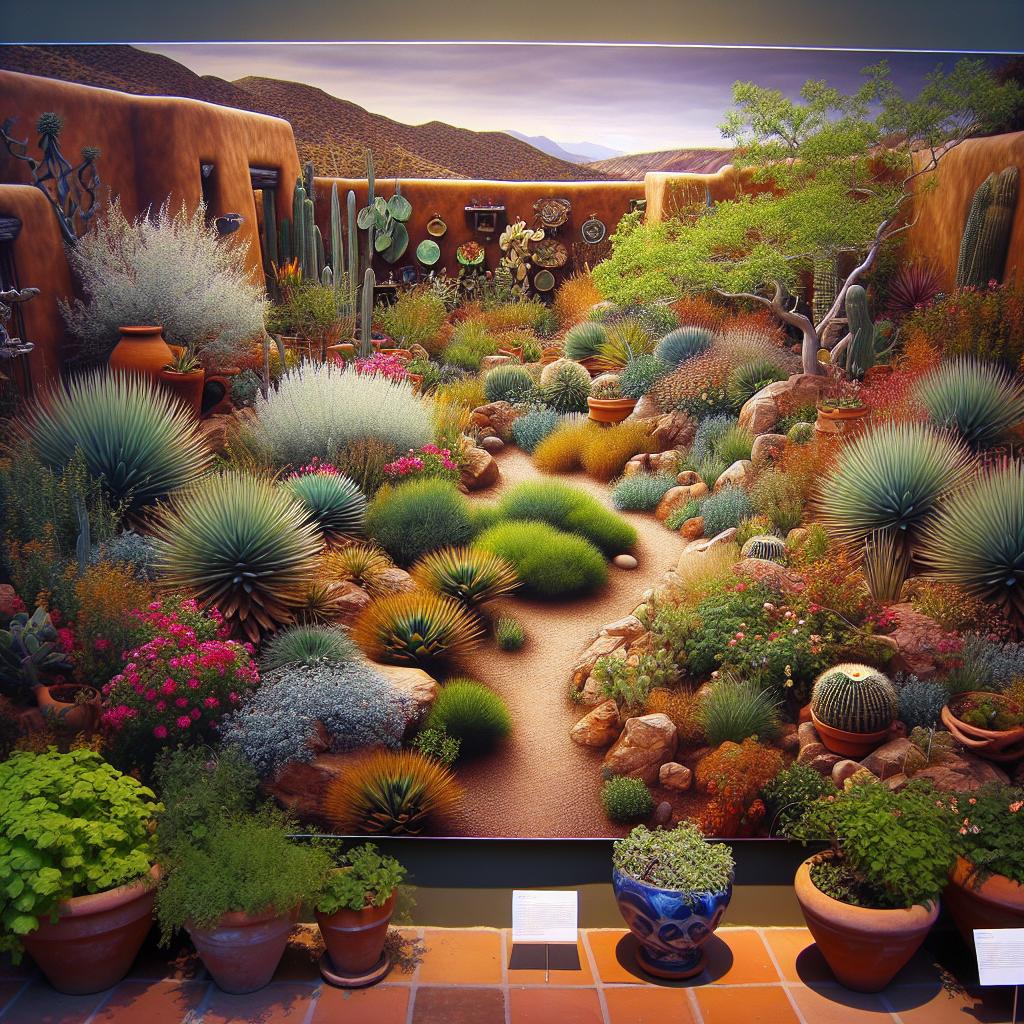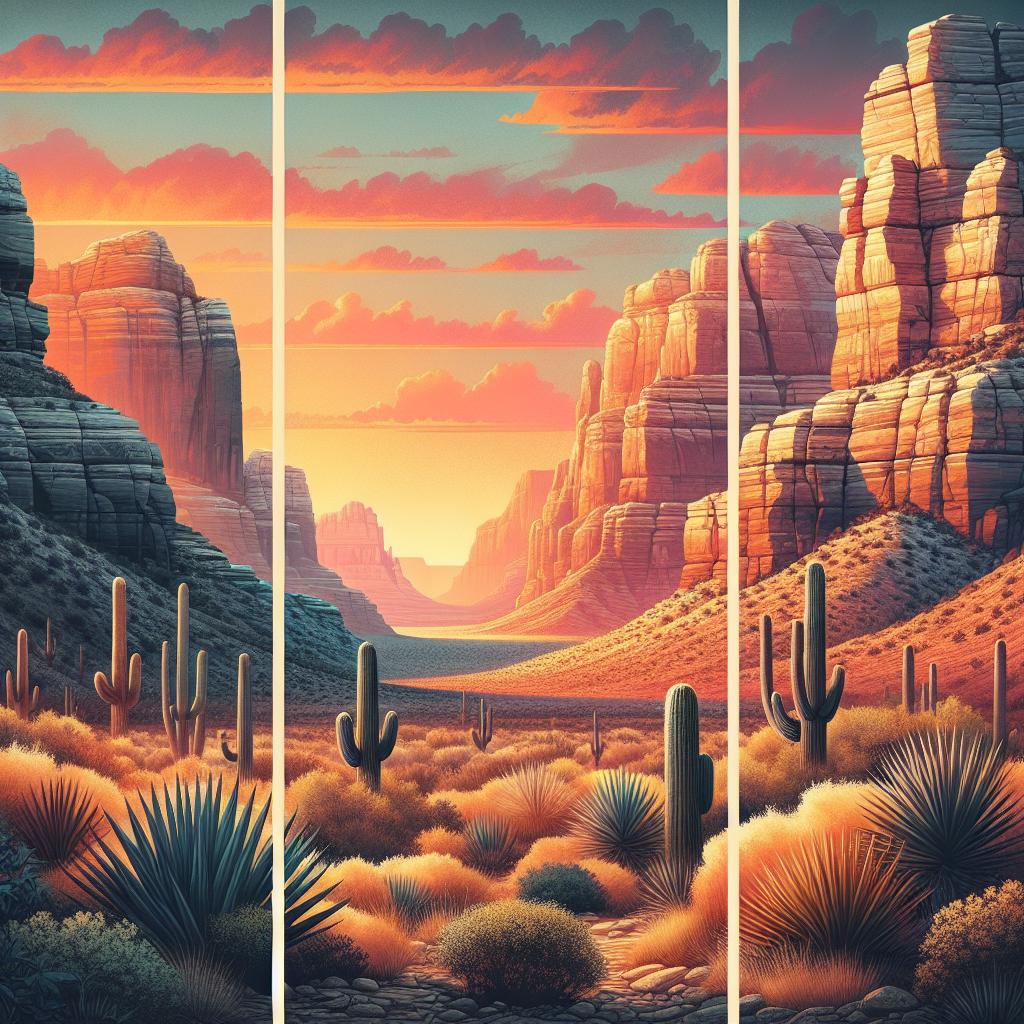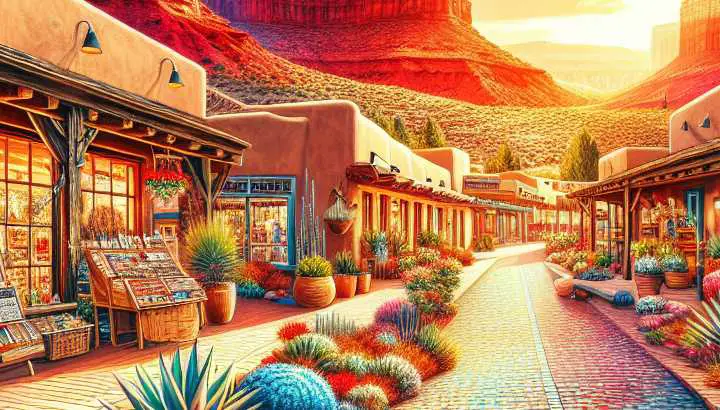The Art of Southwestern Landscaping

1. Indigenous plant species in Southwestern landscaping
While the words “southwestern landscaping” might conjure up images of tumbleweeds rolling across desolate landscapes, as any self-respecting desert gardener knows, southwestern gardens are anything but barren. Yes, it’s true, we desert dwellers don’t have the luxury of endless rain and mild seasonal temperatures. But let’s face it, we’ve got something unique – a plethora of indigenous plant species.
Before we delve into the fantastical flora of the Southwest, let me clear up the tumbleweed myth. They’re as native to the Southwest as polar bears. Nope, they were unwanted stowaways on a flaxseed shipments from Ukraine in the late 19th century. They’re basically the botanical version of European settlers, minus the land grabbing, of course!
Preserving the ecosystem, water conservation and reducing maintenance (AKA chill out and enjoy the view) are wonderful byproducts of landscaping with native plants. Plus, it attracts wildlife that evolved with these plants – yum, instant pollinator buffet table!
Let’s talk about the stars of the show – the top indigenous plants that shine brighter than a cowboy’s belt in a Southwest landscape – real plant celebruties!
1. Agave: Currently, there’s a tequila glut and we suspect they’re totally in on it. These succulent belles can withstand merciless heat, put up with zero watering and still look fabulous. Plus, their dramatic flower spikes would make any catwalk model jealous.
2. Mesquites: These tough characters are the Clint Eastwoods of southwest native plants. With their knobbly forms and gruff demeanor, they stand all guns blazing in the harshest of conditions. Sure, they have thorns, but even heroes have their flaws.
3. Prickly pear: This botanical bedazzler is no one-trick-pony.
“Mrs. Knott’s knowledge of landscaping is seen on the grounds which encompass this building”
~ Louis Raphael Nardini, No Man’s Land
It flaunts vibrant blooms, dishes out delectable fruit, and interestingly, its prickles are handy solar panels!
4. Red yucca: It never stops giving. You want fireworks? It’s got flamboyant red flowers that explode like rockets. Yet, can also appease minimalist enthusiasts with its hearty, slender leaves.
5. Penstemon: Spoiler Alert – These are cheaters. They appear easy-going, yet stealthily flaunt glamorous trumpet-shaped blossoms to draw hummingbirds lured by their siren call, right to your backyard.
6. Turpentine bush: It may sound like something out of a chemist’s cabinet, but the turpentine bush is the plant equivalent of a superb roadie – holding the stage firmly in late fall and winter with its rustic yellow flowers when others take a bow.
7. Purple sage: Contrary to popular belief, it isn’t just an Old West novel. This dazzling plant, also known as “barometer bush,” wears lavender daisies when rain is looming. So, you not only get a stunning landscape but a weather forecast too!
So, folks, stop envying those folks in the tropics. With the right plants and a little water (just shy of a cactus martini) you can have a boot-stomping, cowboy-hat-tipping, yee-hawing piece of gardening glory right in your backyard. Embrace the expressive, colorful, and defiant character of our indigenous southwestern plants. After all, isn’t it a cardinal cowboy code that Mother Nature always knows best?
Like This? Try: 1. Indigenous Plant Species In Southwestern Landscaping

2. Drought-tolerant gardening techniques in the southwest
Article Title: “Thirsty Plants Beware: The Desert Gardeners’ Guide to Drought-Tolerant Techniques”
Let’s face it, the Southwest is as dry as a stand-up comedian on open-mic night. Rain events here are so exciting they practically turn into festivals. Between the abundance of sunshine – we’re looking at you, Arizona – and a rain gauge that often reads like a ghost town’s population sign, gardening can be a bit like farming on the moon, minus the low gravity perks.
But fear not fellow desert dwellers, just because there’s more sand than water doesn’t mean dreams of your lush garden should evaporate. In fact, the plants might beat you at poker, playing their highest hand as local Southwest flora has adapted itself to year-round sun suits. Time to grab your cowboy hat, lasso, and let’s wrangle with some drought-tolerant gardening techniques.
1. “Know Your Locals: Native Plants”
Think about the celebrities that grace our screens; they flourish in the spotlight and are made for the scene. The same truth applies to your potential plant posse. Native plants were born in the hard-knock life of the Southwest. They are adapted to survive, and even thrive, times of drought. Plants like agave, yucca, and Texas sage scoff at the desert heat, saying, “is that all you got?” They can take the heat and stay in the garden, so we surely can’t wrong them by planting more!
2. “Importance of Mulch: The Plant’s Peacoat”
Mulch is to gardening what a peacoat is to a chilly walk back from the bar. Not only does it keep the soil cool and classy, but it also retains moisture, suppresses weed growth, and looks super snazzy. Nobody appreciates a warm drink and the same logic applies to plants- they appreciate the cool sip of water just as much as you enjoy that ice cube clinking whiskey.
3. “Say ‘Enough’ to Overwatering”
Sometimes, people think they can solve the drought problem by recreating a miniature Amazon rainforest.
“Skirmishers were deployed to the front, right and left, and the charge was made diagonally over the wheat-field to the southwest, to the woods on the west side, then half-wheeled to the right, then on up through the woods to the crest of the hill, driving the enemy out of the woods in the direction of the Peach-orchard”
~ H. N. (Henry N.) Minnigh , Company K. 1st (Inft,) Penn’a Reserves
Please, don’t be that person. Overwatering not only wastes water but shocks those plants that prefer their soil dry, like a martini. And really, how would you like it if you were forced to drink a gallon of water when you asked for just a pint?
4. “Plan it Right: Landscape Design”
Think of your garden as your own personal Coachella stage. Place those plants strategically, with taller ones in the north and west areas to provide some shade for the smaller guys. Also, remember to group plants according to their hydration needs; the dye-hard drinker should not be put next to the teetotaler.
5. “Soil Amendment: Buffet for Plants”
Good soil is like an all-you-can-eat buffet for plants – complete with nutrients, plenty of ‘healthy’ grub, and even a few luxuries thrown in for good measure. Adding organic matter, like compost or manure, can significantly improve soil structure and its water holding capacity. Your soil condition should feel like a millionaire’s spa, luxuriously laden with all the rich stuff!
6. “Water Wisely”
We’ve saved the best for last. If garden watering were a university course, it’d be “Watering 101: How Not to Drown Your Plants.” Watering in the early morning or late evening reduces evaporation and ensures your plants have time to have a proper soak before dealing with the local solar flare we affectionately call the ‘midday sun.’
Gardening in the Southwest can be a tough gig. But with a bit of humor, understanding, and the right techniques, you can have a garden that could make even a cactus jealous. So don those garden gloves, slap on some sunscreen, and start planting! You might just be the next big hit in the desert gardening scene.
Learn More Here: 2. Drought-tolerant Gardening Techniques In The Southwest

3. Southwestern landscape design aesthetics and principles
Darlings, forget about Zen gardens, French botanical retreats, or English cottage greenery. Let’s take a detour into the sun-baked tapestry like no other – the Southwestern landscape design aesthetics. You will not find anywhere else where the sun-kissed terra-cotta dances across the palette of earthy tones, where cacti proudly hold their arms wide open, shouting, “Look at me! I am fabulous against the dominant blue sky”. So, buckle up, folks. Prick up your ears and put on your sunscreen. You’re about to get a tan from my sizzling descriptions.
First of all, what differentiates the Southwestern landscape from other designs is the mantra of minimalism meeting functionality. It’s the antique Clint-Eastwood-in-a-Spaghetti-Western vibe translated into yards. Its beauty lies in the simplicity and adaptability to the harsh, arid environment. It’s like Frida Kahlo and Georgia O’Keeffe had a garden party and you’re invited.
Say goodbye to those dainty, water-guzzling tulips your grandma adores. Your new best friends are cacti and succulents. These spiky folks are the Kardashians of Southwestern landscapes – bold, eye-catching, and frankly, a bit prickly. We have the saguaro standing tall and proud, tolerating not a drop of nonsense (or water, for that matter). The blue agave – a magnificent rosette that doubles as the source of tequila – adds a touch of blue-green magic to the predominantly ochre terrain.
The second principle is ‘adaptation to local climate and topography’. The Southwestern landscape design uses native, drought-resistant plants and creates an aesthetic that embraces the arid, hot climate rather than fight against it.
“* * * * * Each day the dead from the stockade were carried out by their fellow prisoners and deposited upon the ground under a bush arbor just outside the southwestern gate”
~ William W. Day, Fifteen Months in Dixie
River rocks, pea gravels, and native wood chips are used to fill the garden spaces, maintain soil moisture, prevent weed growth, and decrease erosion. They are the secret environmental warriors; they help conserve water. Meanwhile, in the paved areas, flagstones, colored concrete, and decomposed granite are used, making a thoughtful nod to the natural surroundings. Rocky setting offers a determined ruggedness one can only wish for oneself after a Pilates session.
Finally modern Southwestern landscape design integrates outdoor living seamlessly. Wrought iron furniture, rustic barbecue setups, and adobe fireplaces are the staples. It is all about enjoying the great outdoors with a spice of comfort. Fancy a midnight dinner under the starlit sky next to a mesquite crackling fire? Or perhaps you wish to sip margaritas on a hammock tied between two Palo Verdes? This aesthetic offers it all, a perfect blend of form and functionality with a side of hot chili.
In conclusion, Southwestern landscape design is not just about sunburned rocks, tumbleweeds, and cacti hoarding water. It is not some ‘dusty old boot’ version of landscape aesthetics. Instead, it is a living testament to resilience, innovation, and beauty in adversity. It is a dialogue between nature and art, whispering secrets of survival in the blazing sun and retelling tales of tumultuous thunderstorms.
So, next time you feel parched and drained, remember the saguaro cactus. If it can grow in the desert, embracing its conditions rather than rebelling against them, you can certainly make it through another Monday morning meeting.
Like This? Try: 3. Southwestern Landscape Design Aesthetics And Principles
